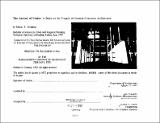| dc.contributor.advisor | Jan Wampler. | en_US |
| dc.contributor.author | Germen, Murat S. (Murat Seyda) | en_US |
| dc.contributor.other | Massachusetts Institute of Technology. Dept. of Architecture. | en_US |
| dc.date.accessioned | 2011-10-17T21:14:42Z | |
| dc.date.available | 2011-10-17T21:14:42Z | |
| dc.date.copyright | 1992 | en_US |
| dc.date.issued | 1992 | en_US |
| dc.identifier.uri | http://hdl.handle.net/1721.1/66339 | |
| dc.description | Thesis (M. Arch.)--Massachusetts Institute of Technology, Dept. of Architecture, 1992. | en_US |
| dc.description | Includes bibliographical references (p. 126-127). | en_US |
| dc.description.abstract | The main focus of this study is to define a flexible approach for the most conventional challenge in architecture of introducing a new building into a fabric, that we sometimes call "context", composed of old buildings that have historic significance. Flexibility of the approach is an important issue since the character can change drastically from context to context. "Respecting the context" is used in architectural language as if it were a crystal dear concept. However, both words (ie. "respect" and "context") are very large concepts in themselves and it is possible to generate various associations, sometimes even contradicting each other, from these words. As a consequence, it was crucial to define the exact personal meaning of "context" by reinterpreting it. In addition, it was important to decide about levels on which "respect" for the "reinterpreted context" can be accomplished. In fact, that is where the flexibility of the approach comes about since the levels to be respected change from context to context. After reinterpretation of these terms, next goal is to provide collaboration of old and new through overlap rather than juxtaposition. The point of overlapping is to offer the possibility of experiencing old and new simultaneously by creating alternating interwoven layers of old and new. Finally, there is a secondary study on existing examples of new interventions in historic contexts. The purpose of this study is to derive possible processes of "respecting/ignoring the context". Defining these different processes will help figuring out "what not to do?" rather than "what to do?" | en_US |
| dc.description.statementofresponsibility | by Murat S. Germen. | en_US |
| dc.format.extent | xv, 127 p. | en_US |
| dc.language.iso | eng | en_US |
| dc.publisher | Massachusetts Institute of Technology | en_US |
| dc.rights | M.I.T. theses are protected by
copyright. They may be viewed from this source for any purpose, but
reproduction or distribution in any format is prohibited without written
permission. See provided URL for inquiries about permission. | en_US |
| dc.rights.uri | http://dspace.mit.edu/handle/1721.1/7582 | en_US |
| dc.subject | Architecture. | en_US |
| dc.title | The Arsenal of Venice : a study on the degree of context-conscious architecture | en_US |
| dc.type | Thesis | en_US |
| dc.description.degree | M.Arch. | en_US |
| dc.contributor.department | Massachusetts Institute of Technology. Department of Architecture | |
| dc.identifier.oclc | 26376581 | en_US |
